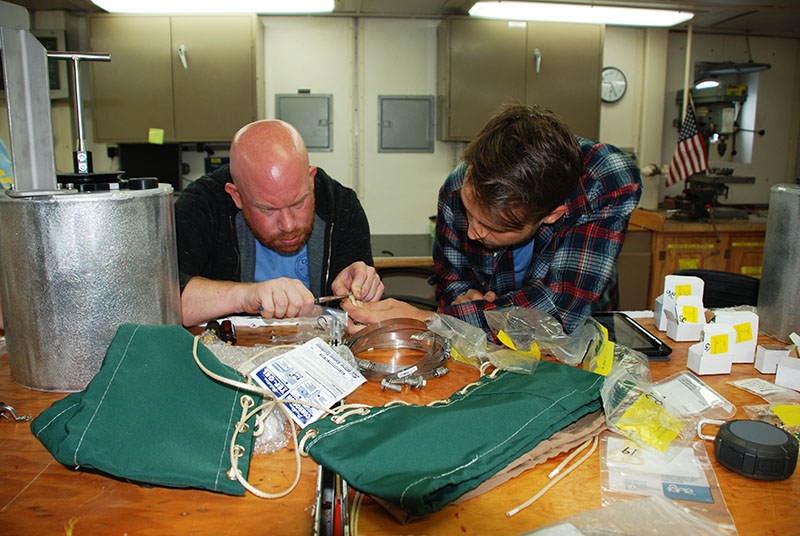
By Caitlin Adams, Web Coordinator, NOAA Office of Ocean Exploration and Research
August 19, 2018
A conversation between Chief Scientist Erik Cordes and Professor Mandy Joye on the R/V Atlantis about the goals of the DEEP SEARCH program, funded by the Bureau of Ocean Energy Management, the U.S. Geological Survey, and the NOAA Office of Ocean Exploration and Research. Video created by Ivan Hurzeler and Erin Henning. Download larger version (mp4, 132 MB).
Though the DEEP SEARCH expedition didn’t leave port until the early morning of August 19, scientists started arriving to the ship as early as Thursday, August 16. The mobilization process for any research cruise is complex and time-consuming, and with nine different science teams aboard, the DEEP SEARCH mobilization was no exception. It takes a lot of gear to accomplish all the different sampling protocols, collections, and analyses we have planned for the next 15 days. With no options for restocking once the ship is underway, scientists must plan their gear lists carefully, ensuring they have enough of every supply, from big items like microscopes all the way down to small disposables like shop cloths.

The R/V Atlantis docked at its home port at the Woods Hole Oceanographic Institution in Woods Hole, Massachusetts. Image courtesy of DEEP SEARCH 2018 - BOEM, USGS, NOAA. Download larger version (jpg, 3.1 MB).
There are five different lab spaces on the main deck of the R/V Atlantis, and we will be using all of them on this expedition. Mandy Joye and her geochemical team have set up the majority of their gear in the hydrology lab, and the Demopoulos lab group is just across the passageway in another wet lab space. The coral scientists will do their sample processing in the biology lab, and most of them, along with the film team, have set up computer workspaces in the main lab, which is also where the previous day’s Alvin dive video will be shown each day after the first dive. There is also a computer lab on the main deck, which is where Jason Chaytor will be stationed as the team’s geology and multibeam mapping specialist.

Chief Scientist Erik Cordes leading a discussion on sample naming conventions. With so many scientists taking a portion of each Alvin sample, it’s important to decide on a standard sample naming system so that all dive information (location, time, depth, etc.) can be properly associated with each sample. Image courtesy of DEEP SEARCH 2018 - BOEM, USGS, NOAA. Download larger version (jpg, 4.6 MB).
By Friday night, all 24 of us had arrived in Woods Hole, Massachusetts, and moved aboard the ship. After getting most of the gear loaded from Wednesday to Friday, Saturday was spent building sampling gear and tying everything down—given the constant motion of the sea, everything in the labs must be secured in some fashion, with ratchet straps, bungee cords, and tape being the most common tools. We also completed our first ship information and safety briefing with the Atlantis Chief Mate Jennifer Hickey and Shipboard Scientific Support Group (SSSGs) Allison Heater and Catie Graver. The first few days portside also gave all of us on the science team a chance to get to know each other: it’s the first research cruise for a number of folks, and the first Alvin cruise for many more (me included!). By the time we all went to sleep Saturday night, we were prepared and excited to wake up at sea the next morning after our 0530 departure.

Jay Lunden posing in his properly donned immersion suit. Image courtesy of DEEP SEARCH 2018 - BOEM, USGS, NOAA. Download larger version (jpg, 2.9 MB).

Jay Lunden and Ryan Gasbarro, both of the Cordes Lab at Temple University, work collaboratively to assemble a newly built mussel pot. These mussel pots will be used on Alvin to collect mussel communities during dives at seep locations. Image courtesy of DEEP SEARCH 2018 - BOEM, USGS, NOAA. Download larger version (jpg, 5.1 MB).
The first full day at sea was also spent—you guessed it—planning and preparing. We had the other half of our safety briefing and all experienced the challenge that is donning one’s immersion suit. Chief Scientist Erik Cordes organized an all-hands science meeting after lunch, which we will continue to hold every day at sea. Smaller teams of scientists met to discuss each of the sample types we’ll be collecting from Alvin: corals, mud, water, and communities (mussels at seep sites and coral-associate animals at canyon and coral sites). Together, they decided how much of each sample type they’ll need to collect and discussed the process for unloading and sorting those samples each day when the sub is recovered. It’s important to get these details worked out in advance of the first dive to minimize the post-recovery chaos as much as possible. We won’t know what samples are coming up until just before the sub surfaces (communication between the sub and the ship is limited during the dive), and everyone needs to be ready to go when the time comes. With the first dive slated for tomorrow, we’ll soon learn just how ready we are!